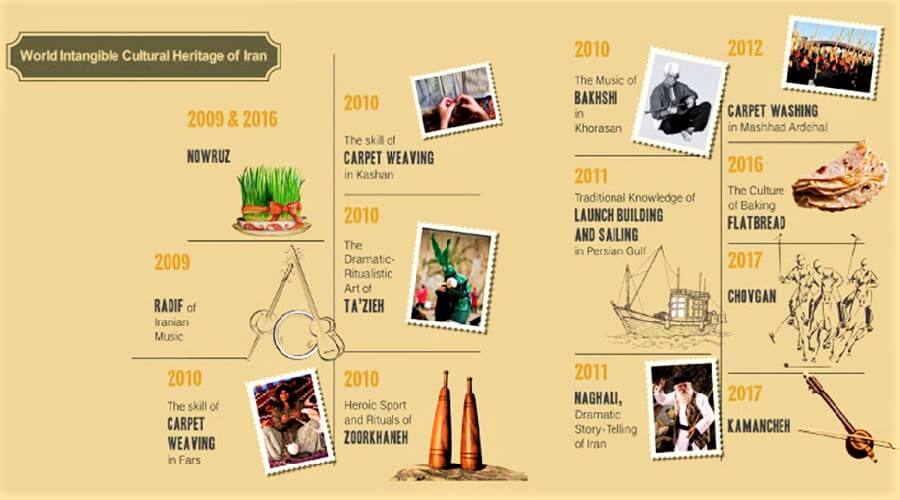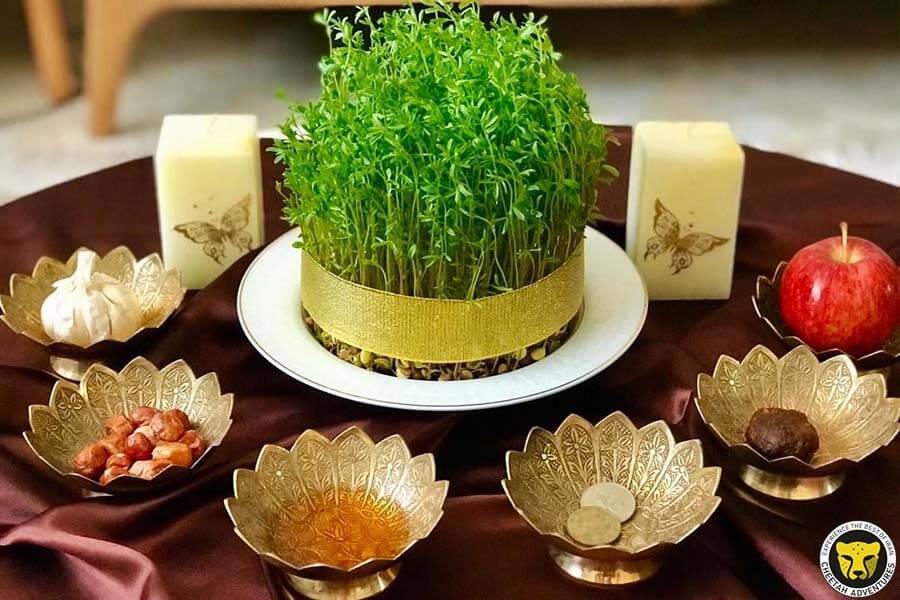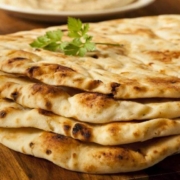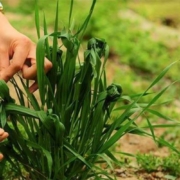Iran UNESCO Intangible Cultural Heritage
The United Nations Educational, Scientific, and Cultural Organization, abbreviated as UNESCO, is a special subsidiary organization of the United Nations.
Its activities are aimed to improve international cooperation in education, culture, and science to increase international peace and welfare. The development of sustainable tourism is one of the most important goals of UNESCO, which is being pursued by introducing the most remarkable cultural attractions in each country.
This goal involves identifying and choosing the best tangible and intangible heritages of each country through a certain process, realizing their natural, cultural, or historical significance, and eventually publishing the results in two separate lists.
Every modern civilization has inherited a set of cultural values and monuments that date back far into history. These cultural values include national traditions and customs, skills and industries, arts, literature, beliefs, etc., and are categorized as UNESCO Intangible Cultural Heritage.
The other category, UNESCO World Heritage Sites, consists of monuments, structures, ancient sites, and also natural attractions.
UNESCO World Heritage Sites
UNESCO World Heritage sites are a group of culturally or naturally significant places registered by UNESCO. These sites include mountains, deserts, lakes, monuments, complexes, and cities and are chosen by the UNESCO World Heritage committee based on predetermined criteria and procedures.
According to the World Heritage Convention, all of the sites included in the UNESCO World Heritage Sites list belong to all mankind regardless of race, religion, or nationality. Therefore, governments are responsible for their preservation.

UNESCO World Heritage Sites
UNESCO Intangible Cultural Heritage
UNESCO’s Intangible Cultural Heritage list, issued by UNESCO, is a complement to the UNESCO Cultural Heritage list that focuses on the valuable, however, intangible part of a country’s cultural heritage.
Items on this list include music, dance, drama, talents, cuisine, handicrafts, and different festivals. These aspects of culture can be recorded, registered, and experienced, but not kept in a physical place such as a museum. In 2001, UNESCO initiated a project which involved doing research in various countries and trying to persuade them for defining intangible heritage and signing an agreement.
This led to the Convention for the Safeguarding of the Intangible Cultural Heritage, which was issued in 2003.
According to the international definition, a nation’s cultural heritage also includes special behaviors, traditions, symbols, skills, tools, knowledge, and handicrafts that have gone down through generations. The UNESCO Intangible Cultural Heritage List consists of two separate lists:
- The long list: This list includes elements of Intangible Cultural Heritage from around the world that help people realize the diversity of cultures and their values.
- The shortlist: This list features those intangible cultural heritages that are in danger of being forgotten and therefore countries must employ the necessary measures to preserve them.

World Intangible Cultural Heritage Of Iran
The UNESCO Intangible Cultural Heritage Criteria
For a cultural heritage to be listed in the UNESCO list, it must meet the criteria set by UNESCO. In this case, the country to which it belongs can request consideration for being registered as a UNESCO Intangible Cultural Heritage.
Each country can present UNESCO a list of top cultural heritage and choose one of the listed heritages for being registered by UNESCO. Then the organization will make the final decision after internal counseling and debate.
Iran UNESCO Intangible Cultural Heritage
Iran, as an ancient country, includes many significant cultural sites and heritage, many of which are listed as UNESCO world heritage sites and UNESCO Intangible Cultural Heritage.
This country’s intangible cultural heritage list includes performance arts, handicrafts, skills related to them, social traditions, customs, rituals and celebrations, nature-related traditions, oral traditions, and other aspects of culture such as dialects, languages, and accents.
So far, Iran’s UNESCO Intangible Cultural Heritage list consists of 16 items. However, this interesting country has many others on the tentative list. We will learn about the current UNESCO list in this article. Note that this list is subject to change.
Art of crafting and playing with Kamantcheh/Kamancha (a bowed string musical instrument)
This Iranian art goes back more than a millennium and is one of the main elements of Iranian Folklore music. It has long been played in Iranian gatherings and can be taught both by solely oral instruction by musicians or academically. This traditional musical instrument is also used for playing songs with different motifs.
This instrument is played by soloists or in orchestras, by both professional and amateur musicians and maestros and students. Kamancheh is an inseparable element of Iranian music and culture and crafting it is the main source of income for its skillful makers and valuable art. Therefore, crafting Kamanche is also a part of Iranian Intangible Cultural Heritage in addition to playing it.
Furthermore, the music of Kamancheh artists usually has various themes ranging from mythical to mystic and even comedy. Nowadays, learning the art of crafting and playing Kamancheh at institutes, music schools, etc. is supported by the government.
(Read about Kamanche on the Unesco website)

Kamancha & Shah Kaman
Chogān, a horse-riding game accompanied by music and storytelling
The Iranian Chogan(Polo) goes back to more than 2000 years ago. This ancient game involves two teams playing on horses and competing to score with the ball. Each team consists of players, a musician, and a narrator.
Chogan(Polo) is also a cultural and artistic element that affects mental and physical health and is intertwined with history and each player’s identity. This Iranian sport is often mentioned in Persian literature and narrations as an element that improves mental and physical health and creates a relationship between humans, horses, and nature.
Traditionally, Chogan skills passed down through generations of Iranian families and Iranian players still preserve its original techniques. In addition, many Chogan clubs have been founded in the last few decades with the purpose to preserve this traditional Iranian game by having classes and supporting local instructors.
Chogan was registered as a UNESCO Intangible Cultural Heritage in the 12th session of the Intangible Cultural Heritage Committee. UNESCO has emphasized the importance of safeguarding and learning this ancient Iranian ritual and sport.
(Read about Chogan on the Unesco website)

Chogan Playing
Flatbread making and sharing culture: Lavash, Katyrma, Jupka, Yufka
Flatbread making became Iran’s second UNESCO shared heritage during the 11th UNESCO committee. It was then registered as a shared cultural element between, Iran, Azerbaijan, Kazakhstan, Kyrgyzstan, and Turkey. However, Iran was chosen as the coordinator of this case similar to Nowruz.
Lavash is a type of crispy flatbread that is usually 3mm thick and is made of semi-yeast dough. This traditional Iranian bread is called Lavash in Iran and Armenia and Armenian Lavash in Georgia. It is also known as Tandoor or Tannour bread. The origin of this traditional bread is known from documents presented by Iran.
(Read about Lavash on the Unesco website)

Flat Bread, Lavash
Nowrouz (Nowruz)
Nowruz is one of the oldest rituals in the world that has passed through generations and centuries for over 3000 years and hasn’t been forgotten. Its deep roots and meaning to those who celebrate it have made it one of the most popular international rituals.
Nowruz, meaning new day, is the new year celebration in the Iranian Solar(Hijri) Calendar and is one of the most ancient celebrations left from ancient Persia.
This celebration is originated from ancient Persia and is celebrated by the people of the Iranian Plateau. This international celebration is coincident with the first day of spring and is the beginning of the new year in Iran and Afghanistan. In addition, Nowruz is a holiday in Tajikistan, Russia, Kyrgyzstan, Kazakhstan, Syria, Iraq, Georgia, Azerbaijan, Albania, China, Turkey, Turkmenistan, India, Uzbekistan, and Pakistan.
Even though Nowruz is an Iranian national celebration, it has long been celebrated by the Turkish people of Uzbekistan, Kyrgyzstan, Turkmenistan, and also Indians. Uzbekistan is also among the countries that cooperated in registering Nowruz on the UNESCO Intangible Cultural Heritage list.
A proportion of this country’s inhabitants, especially those living in Samarkand and Bukhara, speak Persian and this country has many shared cultural bonds with Iran. Nowruz is registered as a UNESCO Intangible Cultural Heritage by the name of International Day of Nowruz. It was registered as a shared element, which shows the unity among the countries involved.
This day is considered holy by Zoroastrians Baha’i.
(Read about Nowruz on the Unesco website)

Nowruz 7 siin
Qalishuyan rituals of Mashhad-e Ardehal in Kashan
The city of Kashan has two famous annual rituals, Golabgiri and Qalishuyan. Qalishuyan ritual takes place in Mashhad-e Ardehal, located 42 km west of Kashan, Iran. This culturally and religiously significant ritual is registered as an Intangible Cultural Heritage both by Iran and UNESCO.
Qalishuyan Ritual takes place on the second Friday of fall, which is coincident with the death of one of the twelve Shia Imams. Therefore, it is also known as Ghali/ Qali Friday. Qalishuyan Ritual is the only religious event, the date of which is set based on the Iranian Solar Calendar. During this symbolic ritual, residents of Kashan wash their carpets using long sticks in a nearby river.
Every year, many Iranians and foreigners travel to Mashhad-e Ardehal, to witness this interesting religious ritual up close.
(Read about Qalishuyan on the Unesco website)

Qalishuyan Rituals Mashhad e Ardehal Kashan
Traditional skills of building and sailing Iranian Lenj boats in the Persian Gulf
The traditional skills of building and sailing Iranian Lenj boats were registered as an element of Iran UNESCO Intangible Cultural Heritage list in 2011. This Iranian skill is mostly common among men residing on the shores of the Persian Gulf and is the main source of income for many of them. Lenj boats are also considered the largest Iranian handicraft.
Lenj is the name given to a small ship or large boat that can carry cargo or passengers and is often sailed in the Persian Gulf, Oman Sea, or the Indian Ocean. Sailing in the Persian Gulf goes way back into history and approximately 2000 years ago. The People of ancient civilizations such as Sumer and Elam used to cross this Gulf and the Oman Sea on their voyages.
Discoveries have shown that the Phoenicians were the first people to live on the islands of the Persian Gulf and sail in the area. Furthermore, during the Achaemenid Dynasty, Darius the Great sent the best Iranian sailors, sailors from Phoenicia and Satraps on journeys to discover the Persian Gulf.
The art of constructing these boats goes back to the reign of the Afsharid Dynasty when Iranians used them for long voyages to India, China, and Africa. The construction of Lenj boats is based on sailboats but they are propelled by engines rather than sails. Iranian handmade Lenj boats are used for fishing, finding pearls, and trading.
(Read about Lenj boats on the Unesco website)

Lenj Boats, Persian Gulf
Naqqali, Iranian dramatic story-telling
Naqqali is a traditional way of storytelling and narrating myths that has its roots deep into the Iranian culture. Traditionally, Naqqal is the person who narrates dramatic and epic stories that are often driven from Shahnameh and are about Iranian heroes and kings.
Naqqali is an old aspect of Iranian Culture and has been common in Iranian society since old times. Naqqals narrate didactic stories with various epic themes such as national values, religious values, and historical and religious events.
They often narrated stories and myths in public or private gatherings and a melodic and intriguing tone. A Naqqal has an intrinsic talent in narrating and skillfully uses grimaces, tones, and gestures to bring a story to life and make it interesting.
They are also extremely capable of memorizing lengthy stories and poems and have an innate ability to improvise. In addition, the narration is often combined with music and illustrations.
The Iranian art of Naqqali was included in the UNESCO Intangible Cultural Heritage list in 2011. However, this traditional entertainment has been fading for the last few decades and needs to be preserved.
(Read about Naqqali on the Unesco website)

Naqqali, Story-telling
Ritual dramatic art of Ta‘ziye
Ta’ziye literally means to mourn and respect the memory of deceased loved ones. The Iranian Ta’ziye is a religious symbolic play that illustrates the events of the Battle of Karbala.
Each person plays the role of a significant character in the story. This play is a traditional and religious show common among Shia Muslims, which is centered around telling the tragic tale of the death of Hossein, the third Shia Imam, and his soldiers and family. Ta’ziye has had an important role in the progress and stabilizing of the theatre in Iran.
This traditional piece is the epitome of Islamic art in Shia. The date of the emergence of Ta’ziye remains uncertain; however, historians believe that mourning rituals in the form of plays originate from mourning for Siavash, an Iranian hero, which was 3000 years ago. The current form of Ta’ziye is estimated to go back to the Buyid Dynasty.
Some of the most famous regions in Iran for Ta’ziye ritual are Lahroud city in Ardabil |Province, Shahroud in Semnan Province, Kariyan in Hormozgan Province, and some other cities spread in Isfahan, Markazi, Qom, Tehran, Qazvin, Alborz, Kerman, Yazd, Hamedan, Khuzestan, Fars, Zanjan, Bushehr and Khorasan.
(Read about Taziye on the Unesco website)

Ritual dramatic art of Ta‘ziye
Pahlevani and Zoorkhanei rituals
The Iranian Pahlavani ritual was included in the UNESCO Intangible Cultural Heritage List as a moral gift to the world. The traditional Pahlavani and Zoorkhanei rituals can be a messenger of peace in the world as this sport has deep roots in morality and culture. Zoorkhanei sport consists of a series of special exercises that are done in the form of rituals and with special equipment.
This traditional sport has been a part of Iranian culture for a long. It is also the oldest fitness sport in the world. Zoorkhanei Ritual gets its name from the place in which it is practiced, called Zoorkhaneh. Zoorkhaneh is a special type of gym in which Zoorkhanei sport and traditional Pehlawani wrestling are practiced.
It has a special structure, for instance, the actual place where the athletes perform is a wide circular hole in the middle of Zoorkhaneh, which is a symbol of the athletes’ modesty. In addition, the entrance is shorter than the average human height and therefore the athletes enter bent as a sign of respect.
Pahlevani and Zoorkhanei rituals follow a special set of customs inspired by Pahlevans(heroes) of ancient times. Chivalry, generosity, and valiance are considered the main characteristics of a Pahlevan.
These along with other Pahlevani customs are conveyed in a poem that Morshed sings along with playing the special rhythm of Zoorkhaneh. The athletes then start their performance, individually or in groups, in sync with the music.
Another Zoorkhaneh tradition is respecting the masters and veterans of the sport by asking their permission both before entering the hole and beginning the performance. Furthermore, the athletes enter in descending order of age.
(Read about Zoorkhanei on the Unesco website)

Zoorkhaneh
Music of the Bakhshis of Khorasan
The music of the Bakhshis people of Khorasan is not only a part of their culture but also a very interesting subject for researchers, travelers, and musicians. Khorasan Region in Iran is sometimes called the Florence of Iran, as it is the origin of this Iranian traditional music.
Bakhshis Music is one of the genres of Iranian music in Iranian Dastgah and Iranian Maqam. Similar to other types of folkloric music, this traditional music of the Khorasan Region is rooted in the life of villagers and nomads of Iran.
In the past, the music of the Bakhshi people was often performed by farmers while working in their fields or taking a break. Some of the evidence suggests that this traditional Iranian music originates from ancient times and has improved as a result of passing down through generations.
One of the unique features of this traditional Iranian music is its instrument called Dutar. Dutar is a folkloric Iranian musical instrument with only two strings that symbolize a couple, a man and a woman.
The players of Bakhshi Music create harmonious melodies that leave a trace on the audience’s mind. The traditional Bakhshis music also includes amazing songs, the most famous of which is called Navai. The great value of the local music of Bakhshis of Khorasan has earned it a spot on the UNESCO Intangible Cultural Heritage list.
(Read about Bakhshis music on the Unesco website)

Bakhshis Music, Dotar Khorasani
Traditional skills of carpet weaving in Fars
The traditional skills of carpet weaving in Fars Province is another element of Iran UNESCO Intangible Cultural Heritage. This historical region of Iran is known as the region of sour and bergamot orange.
This title refers to the agricultural products of Fars Province and the appearance of these fruits on handicrafts. Iranian carpets woven in Fars have long held a special place in the hearts of those interested in this Iranian art. In addition, being registered on the UNESCO list has increased the value of the world-famous Iranian art of weaving carpets.
Traditional skills of carpet weaving in Fars are among the greatest arts of the Nomads of the Fars region and go back more than 1200 years, based on historical evidence.
The oldest evidence about the existence of this Iranian handicraft was discovered among the items of the treasury of Harun al-Rashid. The list found there is from the first half of the 9th century and contains the names of several Iranian carpets.
The Iranian carpets of the Fars region are usually woven at the nimble and skillful hands of Fars nomads and out of wool. The methods used for weaving these carpets usually vary from tribe to tribe; however, all of them are woven using a special type of carpet frame (Daar) that can be carried by cattle, horses, or donkeys.
(Read about Fars Traditional carpet weaving on the Unesco website)

Carpet Weaving, Fars
Traditional skills of carpet weaving in Kashan
The traditional skills of carpet weaving in Kashan are among the most famous and unique Iranian arts. This Iranian art was listed by UNESCO on the Intangible Cultural Heritage list in 2010 and declared the symbol of “carpet weaving skills in Kashan and Iran”.
According to UNESCO, the traditional skills of carpet weaving in Kashan have strengthened the cultural identity of Kashan and are the epitome of creativity and the diversity of Iranian culture. UNESCO has also announced that carpet weaving has a long history in Kashan and today 1/3 of the inhabitants are skilled in this Iranian Art.
Around 60 percent of the carpet weavers of Kashan are women, who have learned the traditional skills of weaving Iranian carpets from their mothers and grandmothers. Men, on the other hand, learn to weave, design, and dye handwoven Iranian carpets by taking internships.
The oldest Iranian carpets woven in Kashan go back to the 18th century, which is considered to be the golden age of industry in Kashan.
One of the unique features of the carpets woven in Kashan is the delicacy of each knot that makes the patterns seem protrusive. These traditional Iranian rugs are so delicately and meticulously woven that the knots are all the same size.
The background of most of the carpets is burgundy with dark blue margins and the patterns are inspired by carpets woven in Isfahan. These patterns include flowers, leaves, branches, animals, or a depiction of historical events.
The artist usually weaves the carpet with the aid of a detailed illustration of its patterns called, Naqshe-e Ghali. Iranian carpets are woven on special frames known as Daar.
They are often made of wool or silk and dyed using the pain derived from natural sources such as walnut shells, pomegranate peels, Vitis leaves, and the roots of Rubia tinctorum.
(Read about Kashan traditional carpet weaving on the Unesco website)

Carpet Weaving, Kashan
Radif of Iranian music
The registration of the Radifs of Iranian Music by UNESCO is a great honor for all Iranians and a demonstration of the potential of this art in Iran. The music committee of UNESCO registered the Radifs of Iranian music during a period of four years and at the end, the Radifs of Iranian traditional music including Dastgahs (Iranian modal systems) of Dastgāh-e Šur, Dastgaah-e Maahur, Dastgāh-e Homayun, Segah, Dastgāh-e Chahārgāh, Rast and Nava were listed as UNESCO Intangible Cultural Heritage.
Radif is the name given to the order of cadences and tunes in Iranian music theory. Each of the melodies, called Gusheh, forms a part of a mode (Dastgah) or Avaz. Radif is a collection of the melodies of traditional Iranian music that are categorized into various modes (Dastgahs) and Avaz. This method facilitates the learning of music.
Radif is not only a collection of Gusheh but also includes their order. In each Dastgah, the Gusheh with the smallest vocal range is chosen as the first one. Radif is in two forms, instrumental and vocal, the former of which is more diverse. The Iranian Radif was created by Ali-Akbar Farahani and his sons who were musicians for the Qajar royal family.
(Read about the Radif music n the Unesco website)

Old Persian Music, Radif
Negargari
Negargari, also called Persian Miniature Painting, is the fifteenth Intangible Cultural Heritage of Iran to be registered with UNESCO. This art has been put on record as a joint heritage among the countries Iran, the Republic of Azerbaijan, and Uzbekistan.
Negargari is popular, globally-loved art, making for a medium that allows the masters to depict the concepts of their culture in glorious forms.
The summit of the art of Negargari goes back to the Safavid Era. Masters such as Kamal al-din Bihzad and Reza Abbasi have created sensational art pieces in historical buildings and mosques of Isfahan and Qazvin.
The Safavid Kings contributed much to this artform by supporting the artists and thus helped the community to appreciate it throughout many centuries onwards.
On top of the wonderous miniature paintings of the Safavid Era, a number of remarkable paintings belong to the Seljuk Era, The Ilkhanate era, the Timurid rule, and the Muzaffarids era.
As the artform Negargari became registered in UNESCO’s list of Intangible Cultural Heritage of Iran, so did the names of the masters of the art of Persian Miniature Painting: Mahmood-e Farshchian, Majid-e Mehrgan, Mahin-e Afshanpour, Ardeshir-e Mojarrad-e Takestani, and Mohammad Bagher-e Aghamiri are the names set down as the masters of Iranian Miniature.

Negargari Art
The Ritual of visiting the Monastery of Saint Thaddeus(Ghare-Kelisa):
In the Mordad of every year, the pilgrimage to the Monastery of Saint. Thaddeus is held in West Azerbaijan Province. This is the sixteenth and the last Intangible
Cultural Heritage of Iran as of the date 1400 and comprises a joint record with Armenia.
Every year in the first week of the month of Mordad, more than 5 thousand Armenians from Iran as well as other lands of the world gather in Ghareh Kelisa for the christening of their children and young adults. Many families go to church every day for the first three days of Mordad and thus perform the rituals in full; however many of the travelers spend only one day in the church.
It is said that Thaddeus was one of the apostles of Jesus Christ who resided in Armenia. In the fullness of time, after Christianity was fully propagated in Armenia, several churches were built in his honor.
The annual rituals of commemoration and remembrance of Saint Thaddeus and his followers are organized in Ghare-Kelisa, in West Azerbaijan Province, as it is one of the most famous churches of the world for this ritual of the world’s Armenians.

Monastery of Saint Thaddeus(Ghare-Kelisa)
In addition to this, the celebration of Yalda Night, Festival of Mehregan, the art of making and playing the Oud, and Persian Calligraphy are all undergoing inquiry with the purpose that they join Iran’s Intangible Cultural Heritage.
Source: UNESCO










Leave a Reply
Want to join the discussion?Feel free to contribute!